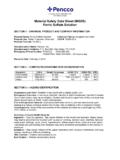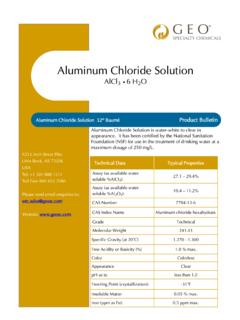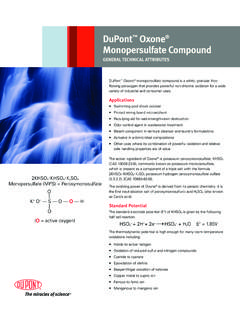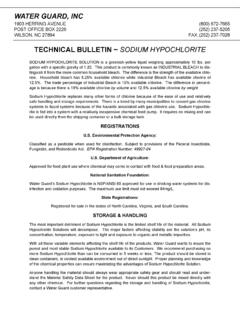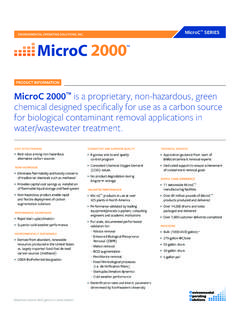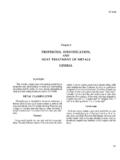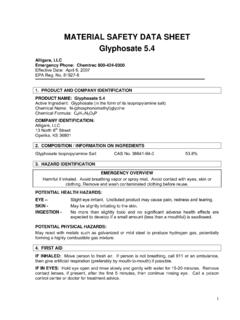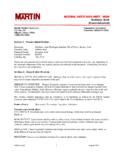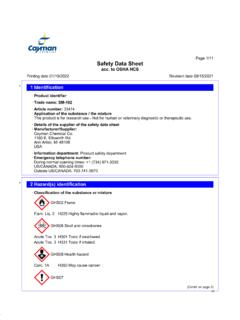Transcription of Ferric Chloride MSDS - Water Treatment Chemicals and …
1 Customer Service 800-864-1742. FAX 888-273-6226. Material Safety Data Sheet ( msds ). Ferric Chloride Solution SECTION 1 CHEMICAL PRODUCT AND COMPANY INFORMATION. Product Name: Ferric Chloride Solution Chemical Family: Inorganic Iron Salts Product Use: Water Treatment Chemical CAS #: 7705-08-0. Product Formula: FeCl3. Manufacturer's Name: Pencco, Inc. Manufacturer's Address: Box 600, San Felipe, TX 77473. Emergency Phone Number: PENCCO (979) 885-005. CHEMTREC (800) 424-9300 24 hours a day Revision Date: February 4 2014. SECTION 2 COMPOSITION/INFORMATION ON INGREDIENTS. Ingredient CAS # Weight Percentage ACGIH TLV OSHA PEL STEL. Water 7732-18-5 58 72% N/A N/A N/A. 3 3. Ferric Chloride 7705-08-0 28 42% 1 mg/m 1 mg/m N/A. 3 3. Ferrous Chloride 7758-94-3 < 1 mg/m 1 mg/m N/A. Hydrochloric Acid 7647-01-0 < 5 ppm 5 ppm N/A. Section 313 Supplier Notification: The hydrochloric acid mentioned above is subject to the reporting requirements of SARA TITLE III Section 313 of the Emergency Planning and Community Right-To-Know Act of 1986 (40 CFR 372).
2 This notification must be included in all msds 's that are copied and distributed for this material. SECTION 3 HAZARD IDENTIFICATION. Appearance and Odor: Reddish-brown liquid with a slightly acidic odor. Emergency Overview: A corrosive chemical. Harmful or fatal if swallowed. Harmful if inhaled. Eye or skin contact may cause irritation. Contact with liquid or vapor form of this chemical may cause severe injury or death. Avoid overexposure. Fire and Explosion Hazards: Substance itself does not burn, but may decompose upon heating to produce corrosive and/or toxic fumes, such as hydrogen Chloride and phosgene gas. Ferric Chloride can react with metals to form flammable and potentially explosive hydrogen gas. Carcinogenicity: None of the components of this material are listed as a carcinogen by IARC, NTP, OSHA, or ACGIH. Summary of Acute Health Hazards Ingestion Toxic by ingestion. May cause irritation to the mouth and stomach. Higher doses may lead to abnormal liver function with nausea or vomiting, stomach pain, diarrhea, fast and weak pulse, lethargy, pallor, shock, hypertension, dilated pupils, fever, coma and even death.
3 Customer Service 800-864-1742. FAX 888-273-6226. Individuals with pre-existing liver diseases may have increased susceptibility to the toxicity of exposure. Inhalation May cause irritation of the upper respiratory tract, resulting in difficulty breathing. Skin Contact Irritation and possibly burns. Eye Contact Irritation and possibly burns. SECTION 4 FIRST AID MEASURES. Eye Contact First Aid: Immediately flush eyes for 15 minutes with large amounts of Water while holding eyelids apart. Washing within one minute is essential to achieve maximum effectiveness. Obtain medical attention IMMEDIATELY after flushing. Skin Contact First Aid: Flush skin with Water . Remove contaminated clothing; wash before reuse. If irritation is still present, seek medical attention IMMEDIATELY. Inhalation First Aid: Remove to fresh air. If not breathing, give artificial respiration. If breathing is difficult, give oxygen. Obtain medical attention IMMEDIATELY. Ingestion First Aid: DO NOT INDUCE VOMITING.
4 Give 1 or 2 glasses of Water or milk. Never give anything by mouth to an unconscious individual. Obtain medical attention IMMEDIATELY. SECTION 5 FIRE FIGHTING MEASURES. Flash Point: Not applicable. Upper/Lower Explosion Limits in Air: Not applicable. Auto Ignition Temperature: Not applicable. Extinguishing Media: Will not burn; use materials appropriate for surrounding fire. Fire and Explosion Hazards: Substance itself does not burn, but may decompose upon heating to produce corrosive and/or toxic fumes, such as hydrogen Chloride and phosgene gas. Ferric Chloride can react with metals to form flammable and potentially explosive hydrogen gas. Fire Fighting Instructions: Firefighters should wear proper protective equipment and self- contained breathing apparatus with full face-piece operated in a positive pressure mode. Move exposed containers from fire area if it can be done without risk. Use Water to keep fire-exposed containers and tanks cool.
5 Hazardous Product of Decomposition or Combustion: Hydrogen Chloride , hydrogen, phosgene. NFPA Rating HMIS Rating 4 = Extreme / Severe Health 2 2 3 = High / Serious Reactivity 0 0 2 = Moderate Flammability 0 0 1 = Slight Customer Service 800-864-1742. FAX 888-273-6226. SECTION 6 ACCIDENTAL RELEASE MEASURES. Review safety precautions before proceeding with cleanup. Use appropriate personal protection equipment. Do not touch spilled material. Neutralize spill with lime (calcium hydroxide), limestone (calcium carbonate), or soda ash (sodium carbonate). Restrict access to area until completion of clean up. Caution: limestone and soda ash will evolve CO2; ventilation should be provided in enclosed areas. Dike area around spill to prevent spreading, and use absorbent material to pick up spill. CERCLA Reportable Discharge (RQ): 1000 lbs. (454 kg), Based on anhydrous Ferric Chloride . Divide by solution concentration to obtain solution weight. Disposal: Under the Resource Conservation and Recovery Act (RCRA), it is the responsibility of the user to determine whether a substance should be classified as a hazardous waste at the time of disposal.
6 This is due to the fact that product use, transformation, synthesis, mixtures, etc. may change the nature of the product. Dispose of waste in accordance with applicable federal, state, and local laws. RCRA: Test waste material for corrosivity, DOO2, prior to disposal. Steps To Be Taken In Case Material Is Released Or Spilled: Notify the appropriate environmental authorities. Note that spills may need to be reported to the National Response Center ((800) 424-8802). SECTION 7 HANDLING AND STORAGE. Handing: Store and handle in corrosion-proof materials (and area). Use FRP or PVC pipes. Be cautious of substance residue in empty containers. Act according to precautions and warnings set forth. Storage: Store in a tightly closed container. Do not store in metal containers. Fiberglass, plastic, or rubber-lined tanks may be used for storage. Protect from damage and keep separated from incompatible substances. SECTION 8 EXPOSURE CONTROLS AND PERSONAL PROTECTION.
7 Respiratory Protection: Adequate general ventilation should be provided to keep vapor and mists below exposure limits. The exposure limits for some components are listed in Section 2. Wear a NIOSH/OSHA approved respirator with a dust/mist cartridge if there is potential of exposure to mists in excess of applicable limits, in any situation where product vapor or mists may be present, such as in confined spaces. Eye Protection: Wear splash resistant goggles and/or safety glasses with side shields. Wear a full face shield if possibility of material splashing or spraying exists. Maintain eye wash fountain. Water should be supplied through insulated and heat -traced lines to prevent freeze-ups in cold weather. Customer Service 800-864-1742. FAX 888-273-6226. Skin Protection: Where there is possibility of skin contact, use the following as appropriate, to avoid skin contact: gloves impervious to material, apron, boots, hood, pants, and jacket. Maintain a safety shower with quick opening valves.
8 Water should be supplied through insulated and heat -traced lines to prevent freeze-ups in cold weather. SECTION 9 PHYSICAL AND CHEMICAL properties . o o Boiling Point: 106 C (223 F) pH: < Melting Point: N/A Solubility in Water : Complete o Specific Gravity: Vapor Pressure: 40 mm Hg @ 20 C. % Volatile: 60 75 ( Water ) Evaporation Rate: N/A. Vapor Density (Air = 1): N/A Molecular Weight: Appearance: Red/Brown Colored Liquid Odor: Slightly acrid SECTION 10 STABILITY AND REACTIVITY. Stability: Stable at normal conditions Polymerization: Will not occur. Decomposition: Decomposes upon heating to produce corrosive and/or toxic fumes, such as hydrogen Chloride . Contact with metals may evolve flammable hydrogen gas. Incompatibility: Rapidly corrodes most metals (titanium is one exception); may generate flammable, potentially explosive hydrogen gas. Avoid contact with nylon, aluminum/aluminum alloys, carbon steel, stainless steel, and copper / copper alloys.
9 Metals, bases, halocarbons, acids, and combustible materials can be considered incompatible. SECTION 11 TOXOLOGICAL INFORMATION. Chronic Effects: Repeated dosage may cause hemosiderosis, including possible damage to liver and pancreas. Toxicological Data: Anhydrous Ferric Chloride Solid Oral LD50 (rat) = 450 mg/kg Carcinogenicity: None of the components of this material are listed as a carcinogen by IARC, NTP, OSHA, or ACGIH. Reproductive Effects: TDLo Rat 1 day (intratesticular) 12976 !"/!"; TDLo Rat 1 day (intravaginal) 29 mg/kg pre pregnancy continuous. Target Organs: No data available. SECTION 12 ECOLOGICAL INFORMATION. Ecotoxicological Information: TLm Daphnia 15 ppm/96 hr fresh Water / conditions of bioassay not specified. Persistence and Degradation: No data available Customer Service 800-864-1742. FAX 888-273-6226. SECTION 13 DISPOSAL CONSIDERATIONS. Under the Resource Conservation and Recovery Act (RCRA), it is the responsibility of the user to determine whether a substance should be classified as a hazardous waste at the time of disposal.
10 This is due to the fact that product use, transformation, synthesis, mixtures, etc. may change the nature of the product. Product containers should be thoroughly emptied before disposal. Dispose of waste in accordance with applicable federal, state, and local laws. SECTION 14 TRANSPORTATION INFORMATION. DOT Shipping Name: Ferric Chloride Solution Hazard Class: 8 Corrosive Material UN Number: UN 2582. Packing Group: III. Reportable Quantity: 1000 lbs (454 kg). Shipping Containers: Rubber-lined steel tank cars/trucks; polyethylene drums, bottles Storage Conditions: Keep containers closed SECTION 15 REGULATORY INFORMATION. OSHA: Hazardous Corrosive Liquid 29 CFR OSHA Process Safety (29 CFR ): No CERCLA: Hazardous Substance Reportable Quantity (RQ) = 1000 lbs (454 kg). SARA Regulations: 313 and 40 CFR 372: No SARA Hazard Categories, SARA Sections 311/312 (40 CFR ): Acute: Yes; Chronic: No; Fire: No; Reactive: No; Sudden Release: No Clean Water Act: Designated as a hazardous substance under Section 311(b)(2)(A) of the Federal Water Pollution Control Act; Ferric Chloride is also regulated by the Clean Water Act Amendments of 1977 and 1978.
